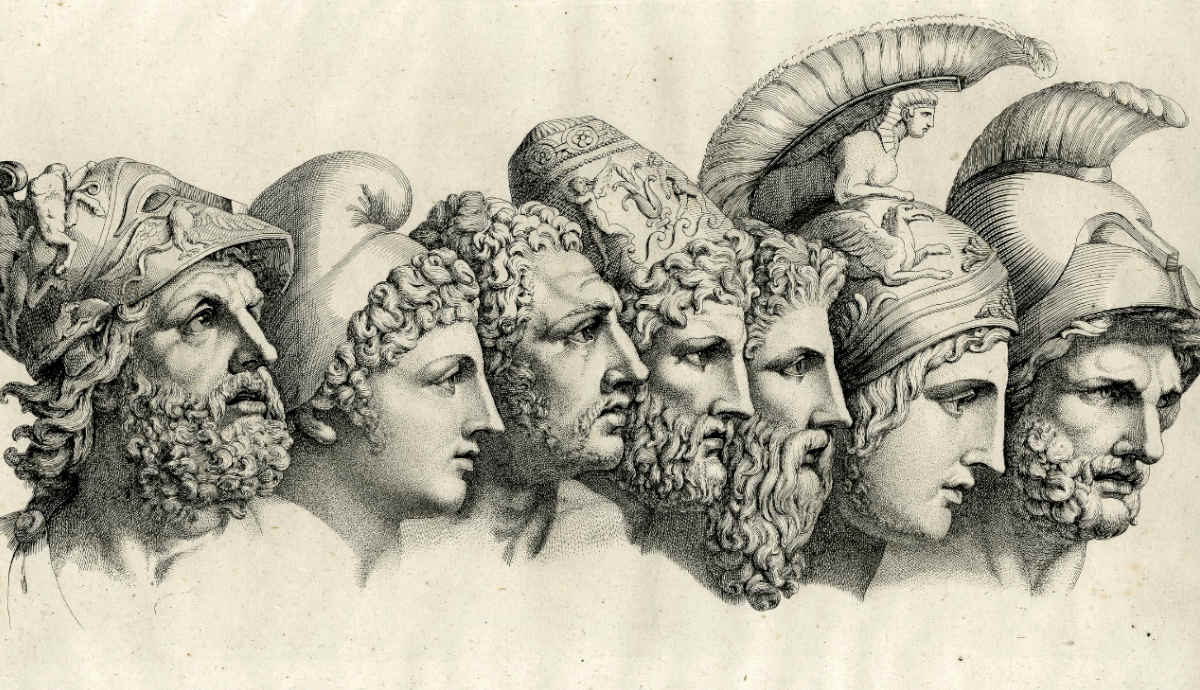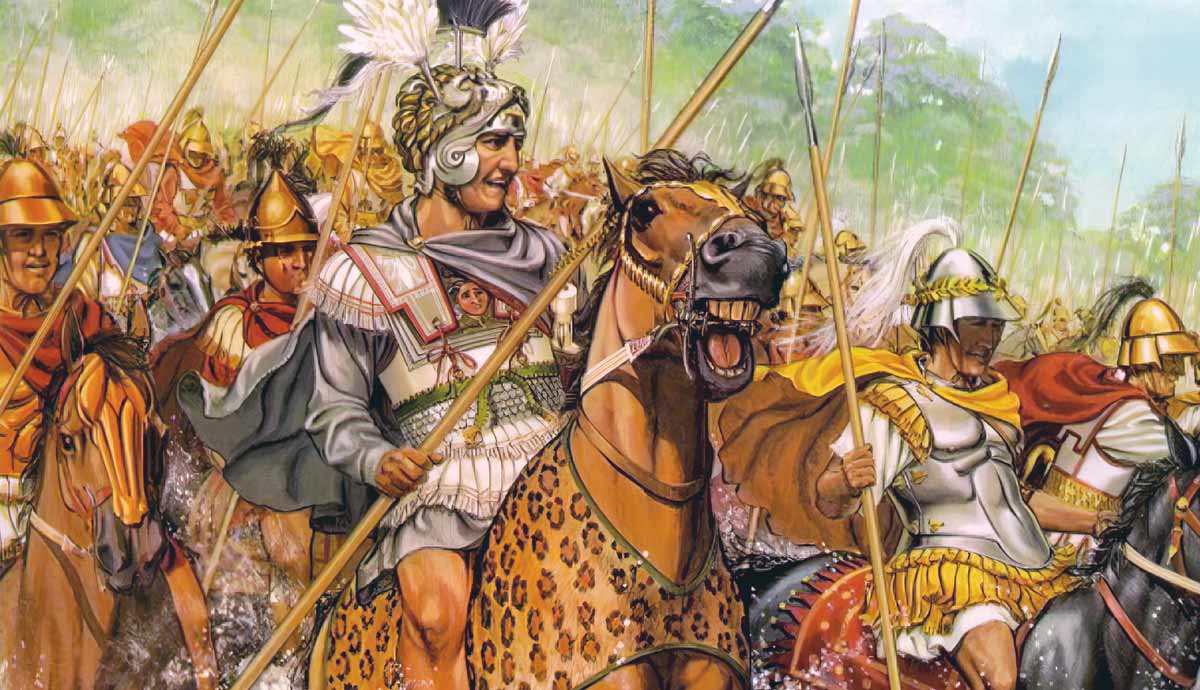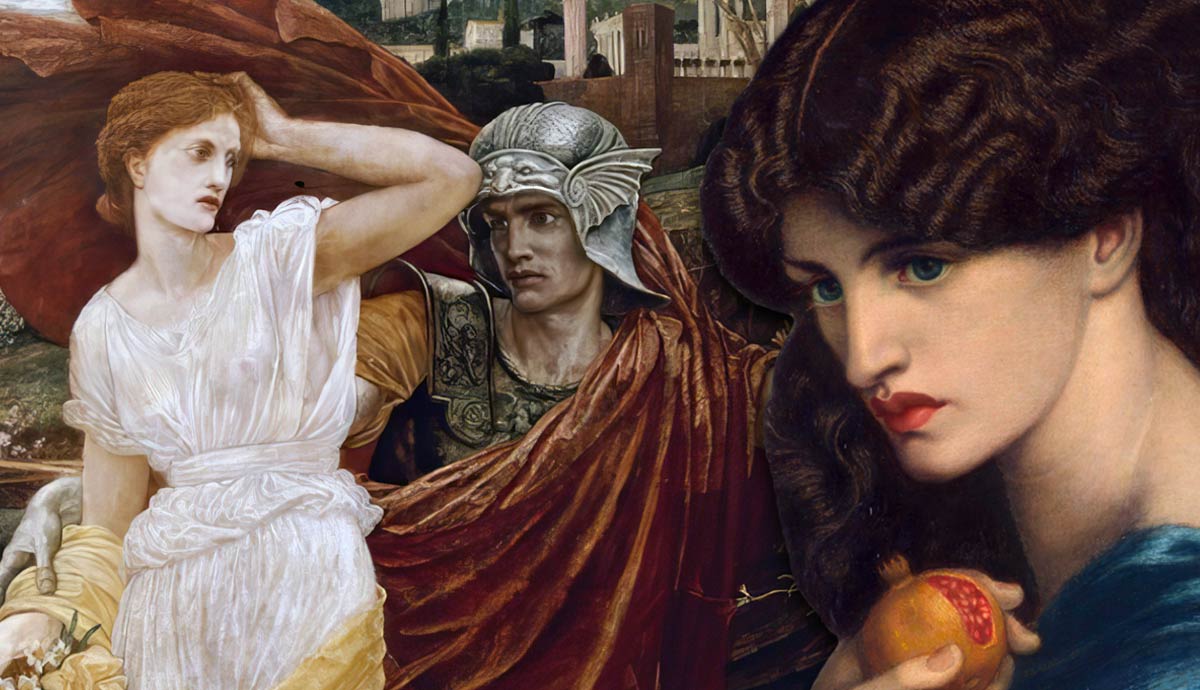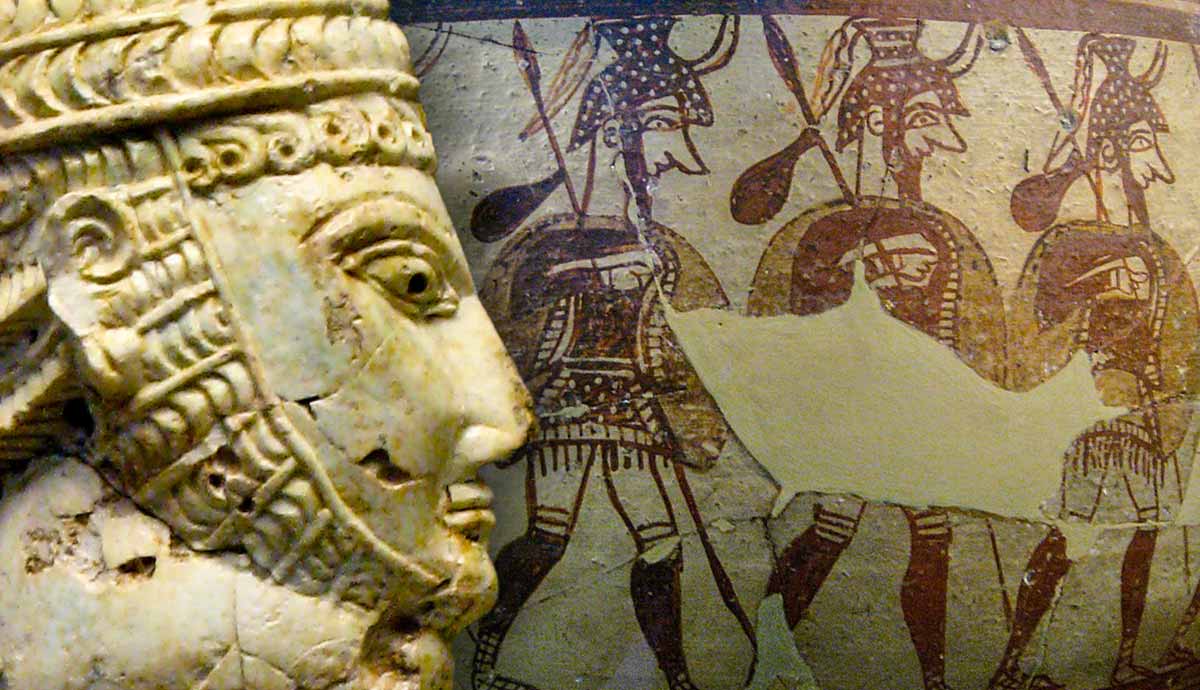
The legendary Trojan War was considered by the ancient Greeks to be the most important conflict of the Bronze Age. It pitted the Greeks (called Achaeans, Argives, or Danaans), imagined to be the Mycenaean ancestors of the classical Greeks, against the city of Troy and its allies in Asia Minor. The epic poem centers on conflicts between the heroes and champions on the opposing sides. Each hero is described in larger-than-life terms, but not all are equal in valor, skill, courage, or intelligence. Meet 13 of the great heroes that fought on the side of the Greeks, how they are portrayed in Homer’s Iliad, and the mark they have left on history.
1. Achilles: The Greek Army’s Greatest Hero

Achilles is portrayed as the greatest hero among the Greeks and is the central character of the Iliad. Achilles was the son of the Argonaut Peleus and the Nereid Thetis, a goddess of the sea. He was trained by the centaur Chiron, who taught him the art of war. It was prophesied that he would either live a long life in obscurity or die young and obtain glory. To avoid this, Thetis dipped him in the river Styx to make him invulnerable; critically, she missed his heel where she held him.
Homer’s Iliad begins with Achilles withdrawing himself and his soldiers from the war after quarreling with Agamemnon, the commander of the Greek army. As the situation deteriorates for the Greeks, Achilles rejects all attempts to mollify him. Finally, Patroclus, his cousin and close friend, convinces Achilles to allow him to take his place at the head of his troops, wearing Achilles’ armor. Patroclus saves the Greeks but is killed, causing Achilles to rejoin the war.

Given new armor forged by the god Hephaestus, Achilles goes on a rampage, slaughtering hundreds of Trojans, fighting the river god Scamander, and killing the Trojan hero Hector. He then holds elaborate funeral games in honor of Patroclus. Achilles goes on to kill Penthesilea, the queen of the Amazons, and Memnon, king of Ethiopia, both of whom were Trojan allies. Achilles himself is killed by the Trojan hero Paris, though this scene does not appear in the Iliad. Achilles’ funeral is instead referenced in the Odyssey.
2. Agamemnon: Commander of the Greek Army at Troy

The king of Mycenae, commander of the Achaean army, and brother of Menelaus, Agamemnon was the most powerful lord in Greece. After Helen of Troy and Paris ran off, Agamemnon gathered the Greek contingents to invade Troy in response to the heinous breach of hospitality. Before the Greek fleet departed, Agamemnon insulted the goddess Artemis. He was forced to sacrifice his daughter Iphigenia to make amends, an act that his wife Clytemnestra never forgave.
According to the Iliad, in the 10th year of the war, Agamemnon again offended the gods by taking Chryseis, the daughter of a priest of Apollo, as a slave. He was forced to return her to avoid plague, and so decided to take Achilles’ slave girl, Briseis. This insult sparked the conflict that led Achilles to withdraw from the war. Agamemnon led the Greeks against Troy without Achilles, with disastrous consequences.

Agamemnon, though not the equal of Achilles in bravery or Ajax in strength, is still one of the greatest Achaean warriors of all the Trojan War Heroes. In one memorable scene, he goes on a killing spree, almost on the scale of Achilles. After the fall of Troy, Agamemnon receives the Trojan princess Cassandra as a prize and delays his return voyage in an attempt to appease the goddess Athena, because Ajax had violated her sanctuary during the sack of Troy. Agamemnon’s eventual homecoming is not a happy one. He and Cassandra are murdered by Clytemnestra and her lover Aegisthus. Orestes and Electra, Agamemnon’s children, eventually avenge his death.
3. Menelaus: Homeric Lord of the Spartans

Husband of Helen, brother of Agamemnon, and king of Sparta, Menelaus appears in both the Iliad and the Odyssey. According to legend, Menelaus was one of many Greek suitors who sought to marry the beautiful Helen. To avoid conflict, her father made the suitors swear an oath to abide by the decision, support each other, and defend Helen’s husband. When Paris took Helen to Troy, Menelaus called on the suitors to fulfill their oath.

In the Iliad, Menelaus challenges Paris to single combat and easily defeats him. However, Paris is saved by Aphrodite, and Menelaus is wounded by the Trojan warrior Pandarus, who shoots him with an arrow. Menelaus helps retrieve Patroclus’ body and is credited with killing eight named Trojan warriors. He is one of the warriors who hid inside the famed Trojan Horse and participated in the Sack of Troy; again, this episode is not recorded in the Iliad, but recounted in the Odyssey. Later, he takes Helen back with him to Sparta after a long journey during which a storm forces them to stop in Crete and Egypt.
4. Odysseus: Architect of the Greek Victory

Odysseus is the cunning king of Ithaca. Always with a plan, he devised the oath that bound the Achaeans to come to the aid of Helen’s husband, though he himself tried to avoid the conflict. His attempt was discovered and exposed by Palamedes, whose downfall Odysseus later orchestrated with the aid of his usual partner in crime, Diomedes. Throughout the story, he often serves as counselor and advisor, especially to Agamemnon. He is the main emissary sent to persuade Achilles to rejoin the war, where he shows his diplomatic skills.

He and Diomedes also conduct several special operations against the Trojans. They kill the Trojan ally Rhesus and steal the Palladium from the temple of Athena in Troy. After Ajax and Odysseus retrieve the body of Achilles, Odysseus is awarded Achilles’ armor, which leads Ajax to commit suicide. Ultimately, it is Odysseus who engineers the fall of Troy. First, he reinforces the Greeks by bringing Neoptolemus, the son of Achilles, and Philoctetes, the wielder of Heracles’ bow, into the Greek camp. He then creates the famed Trojan Horse.
Odysseus is best known for his long journey home, recounted in the Odyssey, which took him ten years. When he finally arrived in Ithaca, he had to use his cunning again to reclaim his palace from suitors keen to marry his still-loyal wife Penelope.
5. Patroclus: The Tragic Martyr at Troy

The son of Menoetius, the king of Opus, and a former Argonaut, Patroclus was sent to be raised alongside Achilles after killing another child over a game. Slightly older than Achilles, he served as a squire, counselor, and wartime companion. Although later Greek authors expanded and reinterpreted their relationship, there is no sexual dynamic between Achilles and Patroclus in the Homeric tradition.
When the war turned against the Greeks and the Trojans threatened the Greek ships, Patroclus convinced the reticent Achilles to lend him both his soldiers and equipment. Wearing Achilles’ armor and carrying Achilles’ weapons, he leads Achilles’ troops. Patroclus drives the Trojans back to the city gates and kills the Trojan hero Sarpedon.

However, Patroclus pushes his luck and is killed by the Trojan heroes Euphorbus and Hector with the aid of Apollo. Hector takes Achilles’ armor, but Menelaus and Ajax rescue Patroclus’ body. A distraught Achilles later holds an elaborate burial and funeral games for Patroclus, and rejoins the war to seek vengeance.
6. Ajax the Greater: Defender of the Greek Ships and Army

The towering Ajax was the son of Telamon and king of Salamis. He was another Argonaut, who also hunted the Calydonian boar, and half-brother of Teucer, another warrior in the Greek army. The strongest of all the Greek warriors, Ajax was trained alongside Achilles by the centaur Chiron. Known as the “Bulwark of the Achaeans,” succeeding despite receiving little assistance from the gods (unlike many other heroes). Throughout the course of the Iliad, he is never wounded.
Ajax often fought alongside Teucer, who sheltered behind his massive shield. Ajax fought a duel against Hector, which lasted for an entire day. They meet again later, when Hector attacks the Greek camp and ships. Ajax is crucial to the Greek defense, nearly killing Hector with a rock and holding off the Trojan army almost single-handedly.

Ajax is one of the emissaries sent to Achilles by Agamemnon to try to convince him to rejoin the fight. He recovers Patroclus’ body after he was killed by Hector, and recovers Achilles’ body after he is killed, with the help of Odysseus. When Odysseus and not he is awarded Achilles’ arms and armor, Ajax’s honor is insulted, and he becomes enraged. Ajax slaughters the Achaean livestock, which Athena causes him to mistake for his enemies. Upon recovering his senses, Ajax is unable to live with the shame of his actions and commits suicide.
7. Diomedes: The Young Greek Rival of Achilles

Youngest of the Greek heroes, Diomedes, the king of Argos, still had more military experience than most of the other champions. Before the Trojan War, Diomedes led a major expedition against Thebes, where his father had died as one of the Seven Against Thebes. During the war, he kills the Trojan hero Pandarus, nearly kills the hero Aeneas, faces Hector, and becomes the only mortal to wound two gods, Aphrodite and Ares, in a single day.

He was also respected for his wisdom and counsel. He was selected as an emissary to Achilles and had a memorable exchange with the Trojan hero Glaucus on the battlefield. Diomedes often partnered with Odysseus on special operations, such as the night raid on the camp of the Trojan ally Rhesus and the theft of the Palladium from the temple of Athena in Troy.
After the Fall of Troy, Diomedes returned safely to Argos but was exiled by his wife and the people who had turned against him. Eventually, Diomedes settled in Southern Italy and founded ten cities in the region.
8. Nestor: Counselor and Advisor of the Greek Army

An Argonaut, who had battled centaurs and hunted the Calydonian boar, the aged hero Nestor was king of Pylos. Too old to engage in combat, Nestor led his troops from his chariot and let his sons, Antilochus and Thrasymedes, do the fighting. Nestor was a skilled public speaker and counselor who often offered his advice to the younger leaders of the Greek army.
There is a subtext of humor in Homer’s portrayal of Nestor, who is never able to dispense his advice without first offering long-winded accounts of his own heroic actions in the past when he faced similar situations. Nestor’s military advice is also often considered anachronistic, more suited to an earlier time when he was younger. While much of Nestor’s advice is of questionable quality, his reputation as a wise counselor rested on his speaking abilities.

After the Fall of Troy, Nestor immediately left for home rather than trying to appease the gods and arrived safely without any issues. He later appears briefly in the Odyssey when Telemachus travels to Pylos seeking news of his father Odysseus.
9. Idomeneus: Cretan Ally of the Greek Army

The leader of the Cretan forces, Idomeneus was the son of Deucalion, an Argonaut who also participated in the hunt for the Calydonian Boar, and the grandson of Minos, remembered for his Labyrinth and the Minotaur. Idomeneus was one of the older Greek warriors and a trusted advisor, but continued to fight on the front lines. He is credited with killing twenty Trojans and three Amazons, and briefly repulsed one of Hector’s most determined attacks.
After the fall of Troy, Idomeneus returns to Crete, but his ships are caught in a terrible storm. In exchange for divine protection, Idomeneus promises Poseidon that, should he survive, he will sacrifice the first living thing he encounters to the god. Upon his return, Idomeneus is greeted by his son, whom he dutifully sacrifices. Angered by this, the gods send a plague to Crete, and the Cretan people exile Idomeneus, who travels first to Calabria in Italy and then to Colophon in Anatolia.
10. Machaon: The Greek Physician at Troy

Telephus, son of Hercules, cured of a potentially fatal wound with some rust from Achilles’ spear, with which he had originally been wounded, Pierre Brebiette, 17th century, courtesy The Wellcome Library[/caption]
Alongside his brother Podalirius, Machaon led the Thessalian contingent of the Achaean army, though he is remembered more as a healer than a fighter. Machaon was the son of Asclepius, the god of healing and medical arts. During the Trojan War, Machaon tended to the various Greek warriors when they were wounded.

His most important contribution to the war effort was the healing of Telephus, the king of Mysia. After arriving off the coast of Anatolia, the Greeks attacked Mysia, mistaking it for the city of Troy. The Greek attack was beaten off, but Achilles dealt Telephus a wound with his spear, which refused to heal.
Seeking a cure for his wound, Telephus journeyed to Argos, where the Greek fleet was regrouping. Machaon revealed that the only way to cure the wound was with rust from Achilles’ spear. When his wound was healed, the grateful Telephus offered to guide the Greeks to Troy. Machaon was killed in the tenth year of the war by Eurypylus, the son of Telephus.
11. Ajax the Lesser: Brutal Greek Hero of the Locrians

The leader of the Locrian contingent of the Achaean army, this Ajax was known as the “Lesser” or “Little” to distinguish him from Ajax, the son of Telamon. He was skilled at throwing a spear and was an exceptionally fast runner; only Achilles was faster. During the funeral games held to honor Patroclus, he competed in a foot race. He was tripped by Athena, who favored Odysseus, so that he finished second.
Later, Ajax participated in the sack of Troy, dragging the Trojan princess Cassandra from the Temple of Athena, and in some accounts, raped her in the temple. After his crime was revealed, he hid from the rest of the Greeks until they departed. As Ajax then made his own way home, Athena caused his ship to sink after it was struck by lightning. Ajax and some of his men survived with the aid of Poseidon and were left clinging to a rock, where he screamed his defiance at the gods. Offended, Poseidon split the rock so that Ajax was swallowed by the sea.
12. Teucer: The Greatest Archer of the Greek Army

This great archer Teucer, from the island of Salamis, was related to heroes on both sides of the Trojan War. He was the half-brother of Ajax the Greater, nephew of King Priam of Troy, and cousin to the Trojan princes Hector and Paris. Homer credited him with killing some 30 Trojan warriors and even with wounding the Trojan hero Glaucus.
During Hector’s drive towards the Greek camp and ships, Teucer teamed up with Ajax, firing his bow from the cover of Ajax’s shield. His attempts to kill Hector were thwarted by Apollo, who redirected his arrows. Hector briefly put Teucer out of commission by flinging a rock at him, but Teucer returned and continued to fight until Zeus caused his bow to break. Teucer later confronted Hector again with a spear and narrowly escaped.
After Ajax committed suicide, Teucer guarded his body to ensure it received a proper burial, but failed to recover his arms and armor. When he returned home after the war, he was banished for not returning with Ajax’s body, arms, or armor. He went on to found the city of Salamis in Cyprus.
13. Philoctetes: Wielder of Herakles’ Bow

Famed as an archer, Philoctetes was the son of Poeas, an Argonaut and the king of Meliboea in Thessaly. As a youth, Philoctetes won great favor from Herakles by being the only one brave enough to light his funeral pyre. Herakles had donned the shirt of Nessus, which was contaminated with the venom of the Lernaean Hydra. Unable to remove the shirt, Herakles built himself a funeral pyre to end his suffering. In gratitude, the newly deified Herakles gifted Philoctetes his bow and arrows, which had been dipped in the venom of the hydra.
On the way to Troy, Philoctetes was stranded on the island of Lemnos by his fellow Greeks, on the advice of Odysseus. There are at least four different explanations for this, but all agree that he received a wound on his foot that festered and had a terrible smell.

After ten years of war, the prophetic Trojan prince Helenus advised the Greeks that Troy would not fall without the bow of Herakles. Returning to Lemnos, Odysseus and Diomedes, or Neoptolemus, discovered that Philoctetes was still alive. After being convinced to sail for Troy, Philoctetes’ wound was healed at the Greek camp. With the bow of Herakles in hand, Philoctetes kills Paris and is one of the Greek heroes selected to hide inside the Trojan Horse.
Major Milestones in the Timeline of the Trojan War
| King Menelaus of Sparta marries Helen, and all her suitors swear to defend him |
| Prince Paris of Troy visits Sparta and breaks the codes of hospitality, abducting Helen to Troy |
| King Agamemnon, brother of Menelaus, gathers the Greek troops, though Odysseus and Achilles try to avoid the draft |
| Agamemnon offends Artemis and must sacrifice his daughter Iphigenia before sailing for Troy |
| The Iliad picks up the story in the 10th year of the siege of Troy |
| Agamemnon offends Achilles, causing him to withdraw from the war effort |
| Patroclus fights in Achilles’ place and is killed by Hector |
| Achilles rejoins the war in grief and vengeance, killing Hector and dishonoring his body |
| Achilles is killed, shot with an arrow by Paris with the help of Apollo |
| Odysseus is given Achilles’ arms and armor, and Ajax kills himself |
| Following a prophecy, Philocetes, wielding the bow of Herakles, is retrieved from an island where he was abandoned, and kills Paris |
| Odysseus devises the plan of the Trojan Horse, and Troy is sacked by the Greeks |
| Each of the Greek heroes begins their journeys home, including the famous ten-year journey of Odysseus |










